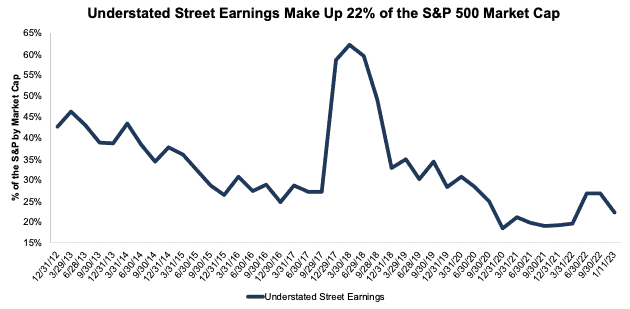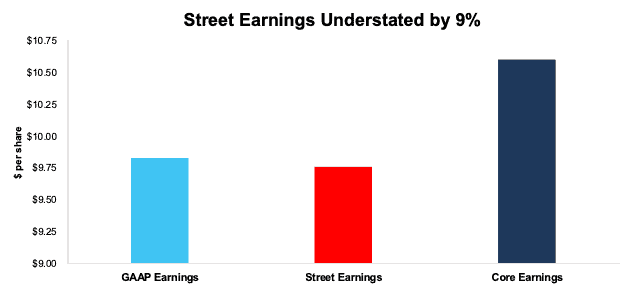While Street Earnings[1] overstate profits for the majority of S&P 500 companies, as shown in Street Earnings Overstated for 76% of S&P 500 in 3Q22, there are many S&P 500 companies whose Street Earnings understate their true Core Earnings[2].
This report shows:
- the frequency and magnitude of understated Street Earnings in the S&P 500
- five S&P 500 companies with understated Street estimates likely to beat 4Q22 earnings
Get our report on the S&P 500 companies most likely to miss 4Q22 Street EPS estimates here.
Street Understates EPS for 143 S&P 500 Companies
143 companies with understated Street Earnings in 3Q22 represent 22% of the S&P 500 market cap as of 1/11/23, measured on a rolling four quarter basis. For comparison, 153 companies representing 27% of the S&P 500 market cap had overstated Street Earnings in the TTM ended 2Q22.
Figure 1: Understated Street Earnings as % of Market Cap: 2012 through 1/11/23
Sources: New Constructs, LLC and company filings.
When Street Earnings understate Core Earnings, they do so by an average of 75%. See Figure 2. Street Earnings understate Core Earnings by more than ten percent for 10% of S&P 500 companies.
Figure 2: Street Earnings Understated by 75% on Average in TTM Through 3Q22[3]
Sources: New Constructs, LLC and company filings.
Five S&P 500 Companies Likely to Beat Calendar 4Q22 Earnings
Figure 3 shows five S&P 500 companies likely to beat calendar 4Q22 earnings because their Street EPS estimates are understated. Below we detail the hidden and reported unusual items that caused Street Distortion and understated Street Earnings in the TTM ended 3Q22 for PulteGroup (PHM).
Figure 3: Five S&P 500 Companies Likely to Beat 4Q22 EPS Estimates
Sources: New Constructs, LLC, company filings, and Zacks
*Assumes Street Distortion as a percent of Core EPS equals the same percent in 4Q22 as the TTM ended 3Q22
PulteGroup: The Street Understates Earnings for 4Q22 by $0.25/share
The Street’s 4Q22 EPS estimate of $2.90 for PulteGroup understates our estimate for 4Q22 Core EPS of $3.15/share by $0.25/share. Large hidden capitalized interest expenses in inventory and reported write-offs included in historical EPS drive the difference between the Street and Core EPS estimates. After removing these unusual expenses, our analysis of the entire S&P 500 reveals PulteGroup as one of the companies most likely to beat Wall Street analysts’ expectations in its calendar 4Q22 earnings report. PulteGroup also had some of the most understated earnings through the TTM ended 3Q22, as detailed in our report here.
PulteGroup’s Earnings Distortion Score is Beat and its Stock Rating is Very Attractive, in part due to its return on invested capital (ROIC) of 17% and price-to-economic book value (PEBV) ratio of 0.3.
Below, we detail the unusual expenses that materially reduced PulteGroup’s 3Q22 Street and GAAP Earnings. After removing all unusual items, we find that PulteGroup’s TTM 3Q22 Core EPS are $10.60/share, which is better than the TTM 3Q22 Street EPS of $9.76/share and GAAP EPS of $9.83/share.
Figure 4: Comparing PulteGroup’s GAAP, Street, and Core Earnings: TTM Through 3Q22
Sources: New Constructs, LLC and company filings.
Figure 5 details the differences between PulteGroup’s Core Earnings and GAAP Earnings so readers can audit our research. We would be happy to reconcile our Core Earnings with Street Earnings but cannot because we do not have the details on how analysts calculate their Street Earnings.
Figure 5: PulteGroup’s GAAP Earnings to Core Earnings Reconciliation: TTM Through 3Q22
Sources: New Constructs, LLC and company filings.
More details:
Total Earnings Distortion of -$0.77/share, which equals -$185 million, is comprised of the following:
Hidden Unusual Expenses, Net = -$0.56/per share, which equals -$135 million and is comprised of
- -$159 million in capitalized interest in the TTM period based on
- $41 million in 3Q22 – disclosed in a Note on Page 13 of the 3Q22 10-Q
- $38 million in 2Q22 – disclosed in a Note on Page 13 of the 2Q22 10-Q
- $34 million in 1Q22 – disclosed in a Note on Page 12 of the 1Q22 10-Q
- $46 million in 4Q21 – disclosed in a Note on Page 53 of the 2021 10-K
- $25 million in adjustments to previously recorded reserves in 4Q21
Reported Unusual Expenses Pre-Tax, Net = -$0.12/per share, which equals -$29 million and is comprised of
- -$38 million in write-offs of deposits and pre-acquisition costs in the TTM period based on
- -$24 million in 3Q22
- -$5 million in 2Q22
- -$4 million in 1Q22
- -$5 million in 4Q21
- $9 million in miscellaneous income in the TTM period based on
- $1 million in 3Q22
- $3 million in 2Q22
- $3 million in 1Q22
- $2 million in 4Q21
Tax Distortion = -$0.02/per share, which equals $4.6 million
Reported Unusual Expenses After-Tax, Net = -$0.07/per share, which equals $17 million and is comprised of
- -$16 million in undistributed earnings allocated to participating securities in the TTM period based on
- -$4 million in 3Q22
- -$4 million in 2Q22
- -$3 million in 1Q22
- -$6 million in 4Q21
- -$0.9 million in earnings distributed to participating securities in the TTM period based on
- -$0.2 million in 3Q22
- -$0.2 million in 2Q22
- -$0.2 million in 1Q22
- -$0.3 million in 4Q21
While not exactly equal, the similarities between Street Earnings and GAAP Earnings for PulteGroup indicate that Street Earnings miss many of the unusual items in GAAP Earnings. The $0.84/share Street Distortion highlights that Core Earnings include a more comprehensive set of unusual items when calculating PulteGroup’s true profitability.
This article was originally published on January 12, 2023.
Disclosure: David Trainer, Kyle Guske II, Matt Shuler, and Italo Mendonça receive no compensation to write about any specific stock, style, or theme.
Follow us on Twitter, Facebook, LinkedIn, and StockTwits for real-time alerts on all our research.
[1] Street Earnings refer to Zacks Earnings, which are adjusted to remove non-recurring items using standardized sell-side assumptions.
[2] The Journal of Financial Economics features the superiority of our Core Earnings in Core Earnings: New Data & Evidence.
[3] Average understated % is calculated as Street Distortion, which is the difference between Street Earnings and Core Earnings.





